
* During World War II, the Soviet Union made extensive use of the Douglas DC-3 twin-piston airliner, which was produced under license in the USSR as the Lisunov "Li-2". In the postwar period, the Soviets moved on to a better twin-piston airliner, the Ilyushin "Il-12", which led to the refined "Il-14". Both the Il-12 and Il-14 were produced in good numbers, to see extensive use in Soviet civil and military service, as well as use by Soviet client states. This document provides a history and description of the Il-12 and Il-14, as well as the prewar Tupolev "PS-35" airliner, and the postwar Ilyushin "Il-18" four-piston airliner.
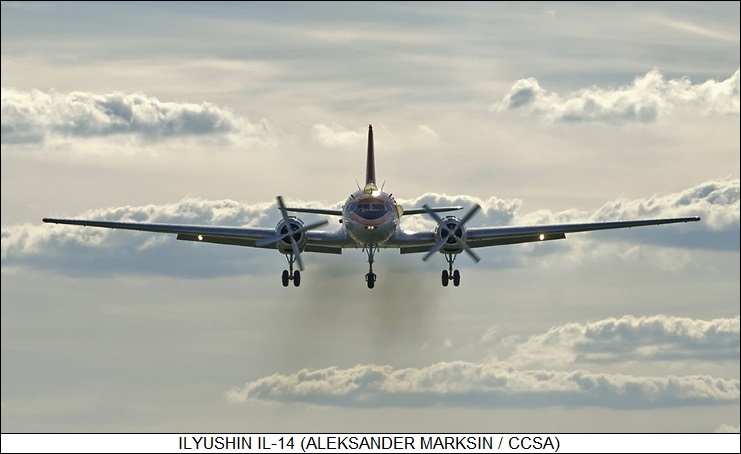
* Aircraft design accelerated rapidly in the 1930s, one aspect being the introduction of greatly improved airliners. The experimental design bureau (OKB in its Russian acronym) led by Andrei N. Tupolev had developed a number of airliners during the 1920s -- though only one, the boxy "ANT-9 / PS-9", was built in any numbers. In 1935, in response to a competition for the design of a fast airliner with a capacity of 5 to 12 passengers, Tupolev OKB engineers decided to leverage work on the OKB's ANT-40 / SB bomber into a fast transport, the "ANT-35".
The first ANT-35 prototype took to the air 20 August 1936, a year after the formal start of the project. It was an attractive twin-engine aircraft of modern design and all-metal construction, with a low wing and tailwheel landing gear -- all gear with single wheels, the main gear retracting backwards into the engine nacelles, the wheels remaining exposed, the tailwheel being fixed. The prototype was powered by French-made Gnome-Rhone 14Krsd Mistral Major M-85 14-cylinder two-row air-cooled radial engines with 640 kW (860 HP) each, driving three-bladed props. Entry door was on the left rear fuselage, with the cabin featuring pressurization and modern comforts for ten passengers. It appears there was a baggage compartment in the rear, with the door on the left.
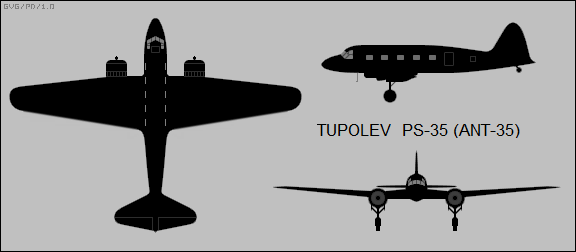
Performance was all that was expected, but the headroom was uncomfortably low, with a second prototype, the "ANT-35bis" -- "bis" being Latin/French for "encore", translating loosely as "plus" -- being flown in 1937 that featured the height of the fuselage raised by 15 centimeters (6 inches). It was powered by US-made Wright Cyclone nine-cylinder air-cooled radial engines, with production machines to use equivalent Soviet-built M-62IR radials, with 750 kW (1,000 HP) each.
___________________________________________________________________
TUPOLEV PS-35 (ANT-35):
___________________________________________________________________
wingspan:
20.8 meters (68 feet 2 inches)
wing area:
57.8 sq_meters (622 sq_feet)
length:
15.4 meters (50 feet 6 inches)
height:
5.66 meters (18 feet 7 inches)
gross weight:
7,000 kilograms (15,435 pounds)
max speed at altitude:
370 KPH (230 MPH / 200 KT)
service ceiling:
7,200 meters (23,600 feet)
range:
920 kilometers (570 MI / 495 NMI)
___________________________________________________________________
Only nine production "PS-35" machines followed, the last being made in 1939. Aeroflot, the Soviet state airline, decided to focus instead on the Lisunov Li-2 airliner, a license-built variant of the US DC-3. The Li-2 was a much more capacious aircraft; being powered by the same M-62IR engines, its performance was not as peppy as that of the PS-35, but it turned out that capacity was more important than high speed. The PS-35s that were built did perform commercial flights up to the German invasion of the USSR in June 1941, to then be pressed into service as military transports. They were used, at least in part, to deliver weapons and supplies to partisan fighters behind German lines. The last PS-35s were phased out of service in 1944.
In parallel with the development of the PS-35, the Tupolev OKB designed a larger twin-engine airliner, the "ANT-50", more in the class of the DC-3 -- but it never flew, the Li-2 making it redundant as well. There was also design work on a four-engine pressurized airliner, the "ANT-53", with a resemblance to the contemporary US Boeing Model 307 Stratoliner. That work didn't go anywhere, either, one of the problems being the arrest of many of the design staff on charges of treason -- there was a lot of that going around at the time. As discussed below, the Soviets would more or less return to the pressurized airliner concept after World War II.
BACK_TO_TOP* In 1943, when it became increasingly obvious that the Soviet Union had the decisive upper hand in the war against Hitler, aircraft designer Sergei Vladimirovich Ilyushin began preliminary investigation of a passenger airliner for the postwar period, with some of the OKB's engineers going to the state factory at Tashkent to inspect production of Li-2s there. Unlike the Tupolev PS-35, which was derived from a bomber design, the Ilyushin "Il-12", as the OKB designated it, was designed from the ground up as an airliner. It was to be an improvement over the Li-2 in all respects, but still be able to use short airfields.
The Il-12 was originally envisioned as having 29 passenger seats; range with a load factor of only 14 passengers was expected to be 5,000 kilometers (3,100 miles) at a cruise speed of 250 MPH (400 KPH). It was to have four M-88V supercharged radial engines, cabin pressurization, and tricycle landing gear. A report on the design was submitted to Soviet dictator Josef Stalin in early 1944; Stalin gave the go-ahead for development of the airliner.
Further work on the Il-12 cut the number of powerplants down to two Charomskiy ACh-31 vee-12 diesel engines, then in development, with a take-off power of 1,420 kW (1,900 HP); passenger seating was reduced to 27. A mock-up was ready by the fall of 1944, with the first prototype of the Il-12 taking to the air on 15 August 1946, just after the end of the war in the Far East. Ilyushin OKB test pilot Vladimir Kokkinaki was at the controls, with his brother Konstantin as co-pilot.
The ACh-31 diesels turned out to be immature and unreliable; there was no saying when all the bugs would be fixed. Consequently, Sergei Ilyushin decided to get rid of the diesels and power the Il-12 with twin Shvetsov ASh-82FN 14-cylinder two-row air-cooled radials, with 1,380 kW (1,850 HP) each for take-off. The ASh-82 was already in production and service, having proven reliable and effective. The Il-12 prototype was fitted with the radial engines, with other changes made as well -- in particular, the landing gear being improved to enhance the Il-12's ability to operate from rough airstrips.
The re-engined Il-12 performed its first flight on 9 January 1946. Although the prototype initially suffered from high vibration levels due to design defects in its propellers, the problems were resolved. Once the Il-12 got flying right, it proved superior in nearly all regards to the Li-2. State trials began in the summer of 1946 and were completed by the fall. The Il-12 had actually been ordered into production before the beginning of state trials, with five pre-series machines available for operational evaluation in early 1947. The Il-12s performed a formation overflight of Moscow on 1 May 1947; Western observers took note, with the aircraft being assigned the NATO reporting name of "Coach". Production of the Il-12 quickly ramped up. Aeroflot pilots liked the machine, finding it pleasant to fly and generally preferable to the Li-2.
BACK_TO_TOP* The Il-12 was an all-metal low-wing aircraft, made primarily of aircraft aluminum, with the twin ASh-82FN engines driving four-blade variable-pitch propellers. The wings had a slight gull configuration, with a relatively steep dihedral inboard of the engines, less steep dihedral outboard. The wings were "stepped" forward between the engines and the fuselage -- this feature having been implemented in early design to accommodate the cooling radiators for the planned ACh-31 liquid-cooled diesel engines, and left "as is" when the design changed to the ASh-82FN radials. The wings had ailerons, plus one-piece flaps in two segments; tail control surfaces were conventional. All flight controls were manually actuated, except for the flaps, which were hydraulically driven. The flight surfaces and windscreen were de-iced by hot air, the propellers with anti-freeze solution.
There were six fuel tanks in the wing center section, with a total capacity of 4,170 liters (1,100 US gallons). A carbon-dioxide fire-extinguisher system was fitted in the engine nacelles. The nose gear featured a single wheel and retracted backwards, while the main gear featured twin wheels and retracted forwards into the engine nacelles. The landing gear was hydraulically actuated; the gear doors were only open while the landing gear was retracted or extended, being otherwise closed to reduce drag. There was a small bumper wheel on the tail to deal with tailscrapes on take-off. A number of photos show a rod that could be attached near the bumper wheel to prevent the aircraft from tipping back on its tail when parked.
___________________________________________________________________
ILYUSHIN IL-12:
___________________________________________________________________
wingspan:
31.7 meters (104 feet)
wing area:
103 sq_meters (1,107.5 sq_feet)
length:
21.31 meters (69 feet 11 inches)
height:
7.8 meters (25 feet 7 inches)
empty weight:
11,045 kilograms (24,350 pounds)
MTO weight:
17,250 kilograms (38,030 pounds)
max speed at altitude:
405 KPH (250 MPH / 220 KT)
service ceiling:
6,500 meters (21,325 feet)
range:
1,500 kilometers (930 MI / 810 NMI)
___________________________________________________________________
Crew included pilot, copilot, navigator, radio operator / flight engineer, and cabin attendant. One of the recognition features of the Il-12 was the fact that there was a second, lower row of cockpit windows on each side. The windscreen had windshield wipers. Avionics were typical for the era, including autopilot, radios, intercom, and radio navigation aids, but no weather radar. Sources do not indicate the baseline Il-12 had an identification transponder, but it did have ejector tubes for parachute flares in the rear fuselage, to aid emergency landings at night. There was an astrodome for the navigator behind the cockpit.
The initial default seating arrangement was for 27 passengers, in nine rows of three seats each. There was a galley, toilet, and coat closet in the rear -- with a baggage compartment in the extreme rear, with a door for access on the left rear fuselage. After a crash, the cause of which was not determined, in consequence of the general safety review following the accident, the number of passenger seats was reduced to 18, with a second baggage hold installed forward, to reduce the weight to be hauled on a single engine; later experience suggested this was cutting back too much, and so the number of seats was raised to 21.
There were rectangular passenger windows on both sides of the fuselage. The entry door was on the left rear fuselage, the door opening outward, with hinges on the forward edge. There was an emergency exit over each wing -- the emergency exits were originally forward of the wing, but since that put them roughly parallel to the propeller arc, that was judged a bad idea. There were a number of variations on seating configurations:
The VIP transports were only made in small numbers; the fancier they were, the smaller the number.
BACK_TO_TOP* Following a notably disastrous crash of an Il-12 near Voronezh in 1948, with all on board killed, a thorough safety review was conducted, with a number of changes made:
While some of these fixes may have been added to late-production baseline Il-12 airliners, they were consolidated in the second main production variant, the "Il-12B". It could be easily recognized by the forward tailfin fillet. Along with regular airliners, two were built as VIP transports.
There were also military cargolifter variants of the Il-12, beginning with the "Il-12T" transport, introduced into production roughly in parallel with the baseline Il-12 in 1947. The Il-12T looked much like the baseline Il-12, except for a double cargo door on the left rear fuselage, replacing the passenger door. The forward door hinged open to the front, the rear door to the rear, giving enough of an opening to load a jeep or small artillery piece or the like, using ramps. There was an inset passenger door in the rear cargo door, opening inward to permit parachute jumping.
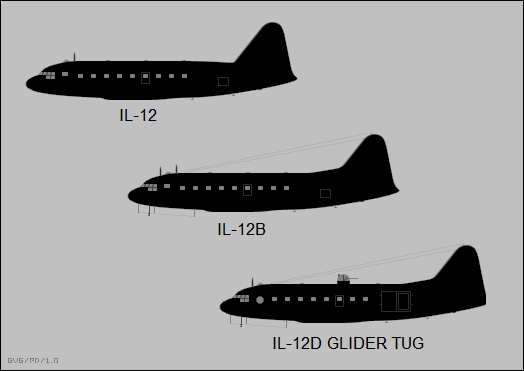
The passenger door on the right was retained, though it opened inward instead of outward. The Il-12T had a metal floor with tiedowns, replacing the wooden floor of the baseline Il-12. It also had overhead winches for cargo handling, and tip-up seats along both walls of the fuselage. Maximum payload was 3,000 kilograms (6,600 pounds). Some Il-12Ts were used as tugs for assault gliders, with the tailcone of the Il-12T removed for the glider tow hitch.
With the introduction of the improved Il-12B airliner, a more optimized military transport variant, the "Il-12D", was introduced, with the tailfin fillet again a distinctive recognition feature. It had a door arrangement like that of the Il-12T, it seems with some improvements. It added three stores racks that could be fitted to the belly to carry bombs, anti-ship mines, or (more realistically) stores containers, and had two hatches in the floor for dropping small bombs or cargo. There was a bubble window on the left side of the fuselage, behind the cockpit, with a bombsight system for aiming bombs or cargo drops, and a camera under the tail to validate bomb or supply drops.
A UTK-1M ball turret could be fitted to the top of the Il-12, the turret being armed with a single Berezin UBT 12.7 millimeter (0.50 caliber) machine gun. Sources claim that early on, the turret was fitted with a ShKAS 7.62 millimeter (0.30 caliber) machine gun. There were ports in the passenger windows, except those over the wings, to allow troops to fire light machine guns or automatic rifles. As with the Il-12T, some Il-12Ds were used as glider tugs, with the tailcone removed for the tug cable attachment; however, when gliders were finally given up, the tailcones were restored to all Il-12s used as tugs.
The Il-12D was introduced to service in 1948. A total of 663 Il-12s of all variants was built into 1949, with a number operated by some Warsaw Pact nations and China, in commercial or civil service. Aeroflot not only flew Il-12 airliner variants, but also military transport variants. It is unclear if Aeroflot flew them as civil cargolifters, or if they were flown in some semi-military role: Aeroflot had a close relationship to the military, the joke being that the military owned all the airplanes, but was nice enough to let Aeroflot fly them sometimes.
A number of Il-12s were flown by Soviet Polar Aviation for Arctic / Antarctic duties, some of these machines being fitted with ski landing gear. In a particularly interesting incident, in April 1950 two Polar Aviation Il-12Ds towed two cargo gliders to the North Pole in support of an Arctic expedition. A few Il-12s were fitted with cameras for survey mapping, and a handful were used for test and trials. While the Il-12 was out of first-line service by 1960, it lingered in secondary service into the 1970s. Some survive on static display; it doesn't appear any are still flying.
BACK_TO_TOP* Even as the Il-12 was going into production, Ilyushin OKB engineers were worrying about its engine-out handling, and what might be done to ensure that it could fly safely on a single engine. There was consideration of more powerful engines, but on examination the problem seemed less one of engine power than of aerodynamic design that could handle the strong yaw forces set up when flying with one engine.
The solution seemed to be a redesign of the Il-12, designated the "Il-14", with a new wing, featuring a constant dihedral; no forward extension inboard of the engines; greater thickness, with all fuel outboard of the engines in the wings; and most significantly, a slight forward wing sweep of three degrees at quarter-chord. A little more power was all for the good, of course, and so the Il-14 was to be powered by uprated ASh-82T radials, with 1,415 kW (1,900 HP) each. The ASh-82T also had new settings for more efficient cruise, and a longer time between overhauls of 500 hours.
Flap design was refined, while the landing gear was improved to retract faster and the props were similarly improved to feather faster -- helping to ensure that they wouldn't contribute to drag if an engine failed. The engine cowlings were cleaned up, improving aerodynamics and making service access easier, with the heaters for the de-icing system more neatly stowed in the belly of the cowlings. The fuselage was largely unchanged from the Il-12, though the baggage compartment and toilet were moved forward from the rear. That caused a shift of center of gravity forward, and so a wider tailfin, with a leading-edge fillet, was fitted to maintain yaw stability; it seems likely it helped with engine-out handling as well.
Incidentally, due to the forward shift of the center of gravity, the support strut attached to keep the aircraft from tipping back when parked was no longer needed. Avionics were also updated, with a particular eye for safer operation under bad weather conditions, while changes were made to improve maintainability.
The first Il-14 prototype was more or less an Il-12 fitted as a demonstrator for various planned Il-14 technologies; it took to the air for the first time on 13 July 1950, with Vladimir Kokkinaki at the controls. It was a Friday, and it seems the superstition held, because the flight had to be curtailed after 15 minutes due to technical problems. A second prototype, much closer to production spec, performed its first flight on 1 October 1950, with Kokkinaki at the controls. Trials going well, the type was ordered into production, with initial service deliveries of the "Il-14P" -- "P" for "passazhirskiy / passenger" -- in 1954.
___________________________________________________________________
ILYUSHIN IL-14P:
___________________________________________________________________
wingspan:
31.7 meters (104 feet)
wing area:
100 sq_meters (1,076.4 sq_feet)
length:
21.31 meters (69 feet 11 inches)
height:
7.8 meters (25 feet 7 inches)
empty weight:
12,200 kilograms (26,900 pounds)
MTO weight:
16,500 kilograms (36,380 pounds)
cruise speed:
355 KPH (220 MPH / 195 KT)
service ceiling:
7,000 meters (23,000 feet)
range, typical:
1,500 kilometers (930 MI / 810 NMI)
___________________________________________________________________
In service, the Il-14P proved superior to the Il-12 in all respects: better speed and range, improved handling, and greater reliability. At the time of introduction, the Il-12 was still restricted to 18 passenger seats, and so was the Il-14P. With the relaxation of this restriction, many Il-14Ps were updated to a 24-seat configuration under the designation of "Il-14P-24". After the type had been relegated to secondary service, many were updated to short-haul, high-density 28-seat and 32-seat configurations without a galley, designated "Il-14-28" and "Il-14-32" respectively.
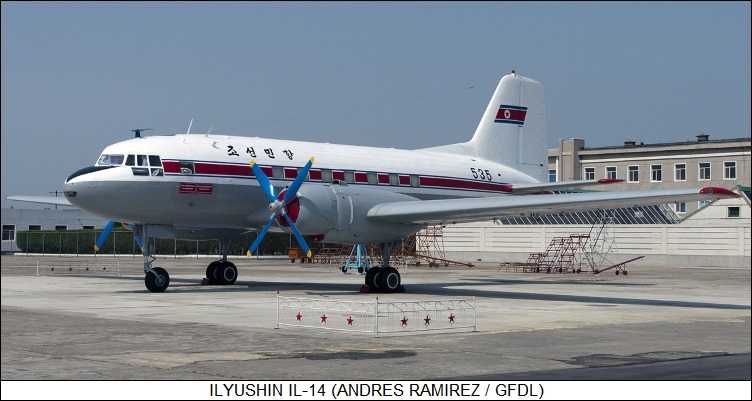
The Il-14P was also the basis for the "Il-14PS" and "Il-14S" VIP machines, along with the extended-range "Il-14SI" VIP aircraft. They had passenger capacities of from 5 to 8; there was also an "Il-14SO" that was similar to the Il-14SI, but had seating for 18, like that of an Il-14 airliner, being intended to haul support and security personnel to accompany an Il-14SI VIP transport. All the VIP machines were built in small quantities.
BACK_TO_TOP* The Il-14P was a bit cramped to carry 24 passengers and their baggage, and so a stretched version, the "Il-14M", was developed, with length extended by a meter, via a fuselage plug in front of the wings, to 22.31 meters (73 feet 11 inches); weight increased by about 6%. Engine power was not increased, but though speed was reduced, handling did not suffer significantly. The airframe was given selective reinforcements, and some niceties were added -- such as a heater in the toilet.
A version with long-range tanks and 14 seats, the "Il-14M-14" was built. Late in the Il-14M's service life, high-density arrangements were also obtained by conversion: the "Il-14M-28", with 28 seats; the "Il-24M-32" with 32 seats and no galley; and the "Il-14M-36", with 36 seats, no galley or cabin baggage compartment.
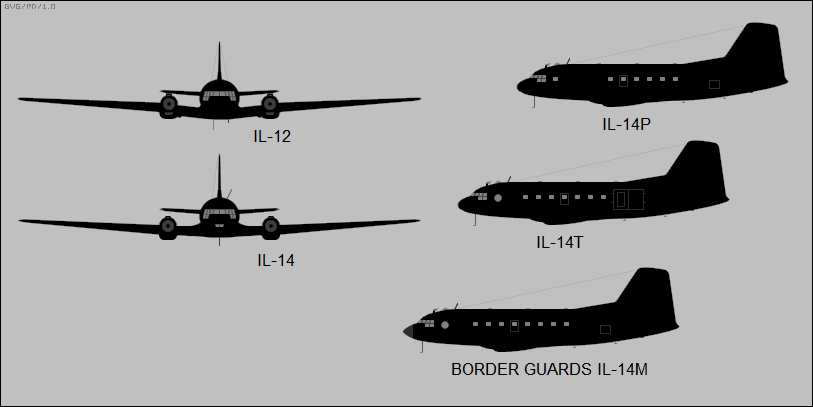
Of course, as with the Il-12, a military transport variant was derived from the Il-14P, with the designation of "Il-14T". Initial flight was on 22 June 1956, with Vladimir Kokkinaki at the controls. Production began early the next year. The configuration of the Il-14T was similar to that of the Il-12D military transport:
Avionics were to Il-14M standard, with military kit added. There were five different Il-14T configurations:
A civilianized cargo hauler, the "Il-14G", was built, lacking the paratroop door in the cargo door; no sighting bubble window nor portholes for weapons; and no militarized avionics. Some Il-14Gs were modified for Soviet Polar Aviation, with auxiliary tanks in the cabin, provision for rocket-boosted take-off, better insulation, a gasoline heater, a gas stove, and an auxiliary generator for ground power.
A total of 839 Il-14s was built in the Soviet Union by two state factories. Although the type was past its prime by the end of the 1960s, it remained in service into the 1990s. It was a flexible platform, an excellent "flying truck", and as described below, was assigned to a number of special missions.
BACK_TO_TOP* The Il-14 was modified into a number of special-purpose variants:
* The Il-14 was also license-built in East Germany and Czechoslovakia. A total of 80 was produced by a state factory in East Germany and designated with the acronym "VEB" -- meaning "Volkseigener Betrieb (People's Enterprise)", a term applied to any state industrial organization. The VEBs were all Il-14Ps, no Il-14Ms, though oddly they had 26 seats, a configuration not seen in Soviet-made Il-14s. A handful were configured as VIP transports.
Some of the VEB Il-14Ps were fitted out as Il-14T military transports, though also oddly, many didn't have the double cargo door -- apparently they were intended as paratroop transports -- and some had an upward-hinged cargo door on the rear right side. In addition, VEB Il-14s were converted to photo-survey platforms, a navaids calibrator, at least one as a navigator trainer, and used for test and trials.
The Czech Il-14s were built by the Avia organization, with 204 "Avia-14" machines built from 1956 to 1960, all based on the Il-14M. The baseline airliner was available in 24, 32, and 40 seat configurations as the "Avia-14-24", "Avia-14-32", and "Avia-14-40" respectively, with some VIP transports produced as the "Il-14S". In addition, Avia built military transports much like the Il-14T as the "Avia-14T", the only significant difference being wingtip tanks.
Late in production, Avia developed the "Super 14", the primary distinction being circular windows and wingtip tanks. It could have 32, 36, or 42 seats, being named the "Super 32", "Super 36", or "Super 40" respectively. There were also special mission conversions, including a navaids checker; photo survey aircraft, including some with an oversized nose for a navigator; and navigation trainers. One Avia-14 was used for trials of the Walter M 601 turboprop for the LET L-410A Turbolet feeder liner, with the engine mounted under the Avia-14's nose.
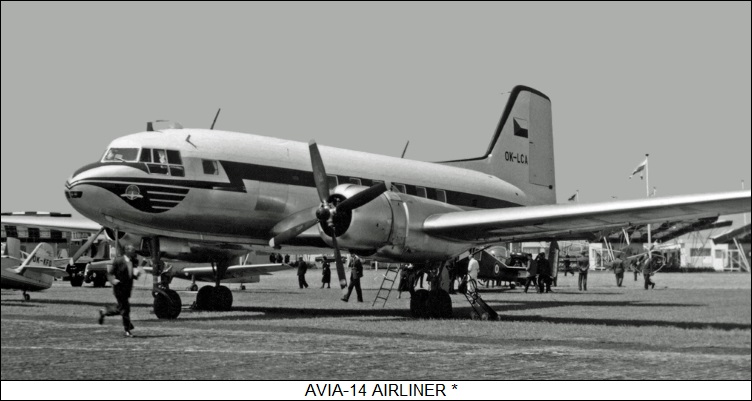
* Total production of the Il-14 was 839 + 80 + 204 == 1,123 machines. Along with the Il-12, the Il-14 provided the backbone of Soviet civil air service in the postwar period -- and also proved very useful to the Soviet military, as well as Polar Aviation. The Il-14 was supplied to all Warsaw Pact nations and China, as well as Afghanistan, Burma, Congo, Cuba, Egypt, Guinea, India, Indonesia, Iran, Mali, Mongolia, Nepal, North Korea, Syria, Vietnam, Yemen, and Yugoslavia. A few even ended up in the hands of private owners in the USA. A number survive as static displays, with a few still flying in the airshow circuit.
BACK_TO_TOP* As mentioned above, before the war the Tupolev OKB had tinkered with the design of a four-engine airliner, the ANT-50, along the lines of the Boeing Stratocruiser. At the end of the war, work on big airliners revived, with the Tupolev OKB flying a prototype of the "Tu-70", derived from the Tupolev "Tu-4" clone of the Boeing B-29 Superfortress, as well as of a military transport derivative, the "Tu-75".
The Ilyushin OKB worked on a four-engine airliner in parallel, which emerged as the "Il-18", the prototype taking to the air on 17 August 1946, with Vladimir Kokkinaki at the controls -- assisted by his brothers, Konstantin and Pyotr, co-pilot and flight engineer respectively. The Il-18 had a general resemblance to the contemporary Boeing C-97, possibly reflecting influence from the B-29 as well.
The Il-18 was an all-metal aircraft with a low wing, four piston engines, a conventional tail arrangement, tricycle landing gear, and a rounded-off nose. The wing featured high-lift devices for operation off of relatively short, and possibly unimproved, airstrips. Flight surfaces were de-iced by an electrothermal system; propeller blades and the windshield were de-iced by hot engine bleed air.
The powerplants were originally planned to be Charomskiy ACh-32 vee-12 diesels, but the Il-18 actually flew with Shvetsov ASh-32TK 18-cylinder two-row air-cooled radials, with 1,790 kW (2,400 HP) each, turbocharged and driving four-bladed variable props. Early flights were with ASh-32 engines, without turbochargers. All landing gear had dual wheels, the nose gear retracting backward and the main gear retracting forward into the inboard engine nacelles.
___________________________________________________________________
ILYUSHIN IL-18 (FIRST PASS):
___________________________________________________________________
wingspan:
41.2 meters (134 feet 10 inches)
wing area:
140 sq_meters (1,506 sq_feet)
length:
29.86 meters (97 feet 11 inches)
empty weight:
28,900 kilograms (62,810 pounds)
gross weight:
42,500 kilograms (93,695 pounds)
max speed at altitude:
565 KPH (350 MPH / 305 KT)
service ceiling:
10,700 meters (35,000 feet)
range:
6,200 kilometers (3,850 MI / 3,350 NMI)
___________________________________________________________________
Standard accommodations were 66 passenger seats, in a five-across format -- it's interesting to note that, while the Il-18 was regarded as a large airliner at the time, that's about the capacity of a modern regional jet. A 27-passenger "sleeper" configuration was also considered. Fittings included toilets, a galley, and two underfloor baggage holds. There were passenger doors fore and aft -- on the right side of the fuselage, as was the custom of the time -- and circular windows, which could withstand pressurization cycles better than square ones.
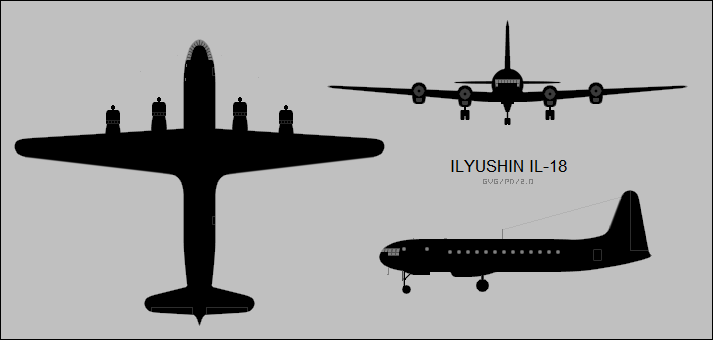
The Tu-70, Tu-75, and Il-18 did not go into production; resources were limited at the time, and there wasn't such an outstanding need for a large airliner as to require that one be built. A military transport derivative of the Il-18 never flew. Aeroflot could get by on Li-2s and the Il-12 for the time being, while the VVS focused on the "Tu-4D" air-assault transport conversion of Tu-4 for short-term military transport needs. The Il-18's ASh-73 engines were also not very reliable, and in short supply. The prototypes of the three aircraft served in trials into the early 1950s, with the Tu-75 lost in a crash and the other two machines scrapped.
During the 1950s, the Ilyushin OKB developed a four-turboprop airliner, which was given the unused "Il-18" designation; although it picked up some ideas from the original Il-18, it was a completely new design. The second Il-18 was produced in quantity and proved very successful.
BACK_TO_TOP* Sources include:
* Revision history:
v1.0.0 / 01 dec 14 v1.0.1 / 01 nov 16 / Review & polish. v1.0.2 / 01 oct 18 / Review & polish. v1.0.3 / 01 aug 20 / Review & polish. v1.0.4 / 01 jun 22 / Review & polish. v1.0.5 / 01 may 24 / Review & polish. (+)BACK_TO_TOP
